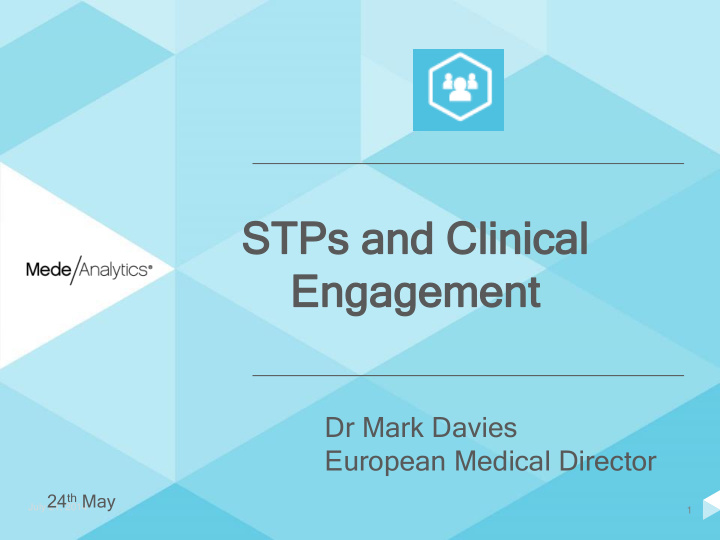



ST STPs Ps an and d Cl Clinical inical Eng ngagement agement Dr Mark Davies European Medical Director 24 th May July 21, 2014 1 1
STPs - changing the language Exam questions are changing … • Organisations Populations • Secondary uses Primary uses • Backward looking Predictive • Activity insights Value • Operation efficiciency Allocative efficiency • Secondary care SUS Integrated data set 2
Population Health Management Population health management is an approach to managing health and well-being that incorporates total care costs and outcomes. It provides insight and improvement opportunities for both populations and individual citizens. 3
4
Population Health Platform : Population Modelling Individual Level Stratification Improvement Opportunities Predictive Analytics Delivery Assurance 5 5
6 6
A joined up view 7
Improvement opportunities Courtesy of Bill Runciman, APSF – Extracted data from AHRQ 2006 report, USA 8
Core Principles – What is Value? Health outcomes Value = Cost 9
OUTPUTS INPUTS PROCESSES OUTCOMES Cake Ingredients, mixing Following the recipe, Happy child bowl, recipe book adding in ingredients, Cake tastes good mixing No food poisoning Blood results, Staff, training, Blood pressure check, Good quality of life blood sugar test, scan results, buildings Getting back to work weight measurement, X-Ray, weight, Able to self-manage examination results assessments Prevent complications February 2014 Less pain Source: Outcomes Based Healthcare, adapted from Alliance (Scotland): We’ve Got to Talk about Outcomes, June 2013 10
Source: Outcomes Based Healthcare Types of Outcomes www.outcomesbasedhealthcare.com 11
Risk Stratification Stratification partitions the distribution of risk scores in any population Hig igh Hig igh Hig igh Hig igh Hig igh Hig igh h Hig igh This is crucial in determining thresholds of risk at which specific actions should (or shouldn’t) be taken, and which resources should be targeted Stratification will only ever consider one outcome at a time 12
Resource Utilisation 12 Cost of Intervention Savings from falls prevented 10 Net savings 8 Net savings lower 95% CI Net savings upper 95% CI 6 4 £ Million 2 0 0.05 0.1 0.15 0.2 0.25 0.3 0.35 0.4 0.45 0.5 0.55 0.6 0.65 0.7 0.75 0.8 0.85 0.9 0.95 -2 Risk cut-off value -4 -6 -8 Based on Surrey Risk Model 13
Is individual stratification unfair? Uniformity Equality 14 14
Risk Stratification in Practice - Public Health Risk Pyramid showing number of people by quartile / deckle of risk GIS map shows substantial number of patients at medium risk of fall in area zone x. Consider putting a health promotion stand in zone x Map by risk group 15
How information is the foundation of an STP A care system that focuses on the whole population. Services should be organised for the population not just the patient who presents. A care system that understand the interdependency of services Optimising services using tailored interventions with segmentation A care system that learns. Using value to incrementally improve quality and safety of care and address variation in clinical practice. Adult to Adult Relationships. Patients and professionals working in partnership. Through sharing knowledge between the two, there is a balance in power. 16
Recommend
More recommend